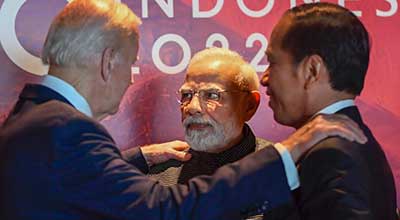Date: 03/01/2023
Relevance: GS-2: Bilateral, regional and global groupings and agreements involving India and/or affecting India’s interests, India and its neighborhood- relations.
Key Phrases: Asian Century, Geopolitical, Economic, Balance of Power, Multipolar, Unipolar, Dominance, Coalitions, Peaceful Coexistence, Sovereignty, International Law.
Context:
- The geopolitical and economic rise of Asia coincides with several regional and global developments which have the potential to undermine the stability and prosperity India had hoped an Asian century would bring.
- The year 2022 was a significant year for India and the rest of the world, and the geopolitical fault lines that were put in motion by 2022 are likely to become much sharper in 2023.
Key Highlights:
- The withdrawal of the U.S. from much of continental Asia and the aggressive rise of China and the Ukraine war appear to have ended the great power show in Asia, or atleast for some time.
- The two major powers Russia and China are trying, to undermine the global balance of power, with several regional powers such as Iran, Turkey and Saudi Arabia in tow.
- Although Asia may be on the rise globally but volatility will remain as its partner.
Asian Century and Multipolarity:
- Asian century cannot be meaningful in a unipolar world. One alternative to a unipolar world is a multipolar world with Russia, China, Japan, India and other smaller powers asserting themselves on the global stage.
- The other alternative is a China-dominated Asia. However, it is clear that a China-dominated Asia won’t serve India’s geopolitical interests
- Would a multipolar Asia be useful to Indian interests?
- A multipolar world/Asia will have shifting alliances, formal, informal, secret, open and in-between pacts and competing coalitions.
- This competition for dominance will invariably take away the relative ‘stability’ of the current world order where the power of the U.S. is on the decline and that of China is (still) on the rise.
- This also does not serve India’s geopolitical interest.
- One of the likely implications of a multipolar world in which Asia takes the centre stage would be a sharpening of opposition against the current global financial order.
- The weaponisation of globalisation and trade, sanctions against Russia and Russia’s attempts in turn at evading them with help from its Asian partners (China, Iran, Turkey, India, etc.) will pose serious challenges to dollar-based trade and Western payment systems such as SWIFT.
- The aftermath of the Ukraine war has led to a serious search in parts of Asia for alternative trading arrangements and payment mechanisms.
India’s Dilemmas:
- India has consistently campaigned for a multipolar world where key Asian
powers have a place at the high table of international politics. Yet it may
hesitate to engage the emergent Asian century for various reasons:
- First - India has a status quoist (A supporter of the status quo) view of the world order despite its frequent calls for change and likes slow, peaceful and consensual transformation of the system which is not what is happening today.
- Second-Unstable Multipolarity: A bipolar international system dominated by China and the U.S. is not favorable for India. If such a world leads to bipolar rivalry, India could often be the target of China.
- Third: If a bipolar world leads to great power accommodation between the U.S. and China, India’s situation could be more problematic. If the U.S. accommodates China as a peer, it could mean the U.S. accepting China’s sphere of influence. This could make India a casualty on the platform of great power politics.
How Real is the Emergence of a China-U.S. G2?
- The more the Ukraine war goes on, the more the U.S./West could attempt to create a working relationship with China (early signs of it with the German Chancellor reaching out to China).
- China has not gone all out in support of Russia’s war efforts this could encourage the West/U.S. to do that.
- For China, an American offer of accommodation in a G2 format outweighs the utility of a closer strategic partnership with an embattled Russia.
Conclusion
- An Asian century with dominating China is highly possible, which is evident from its growing material power, both economic and military, especially with the U.S.’s focus firmly entrenched in the Russia-Ukraine theatre.
- A "Post-Indian South Asia," stuck in the Chinese sphere of influence but not wholly hostile to Indian interests can also be a possibility.
- Navigating the emergent Asian century is not going to be easy for India, but being mindful of its many moods is a good start.
Source: The Hindu
Mains Question:
Q. India has consistently campaigned for a multipolar world where key Asian powers have a place at the high table of international politics. Yet it may hesitate to engage the emergent Asian century. Analyze (250 words)






















